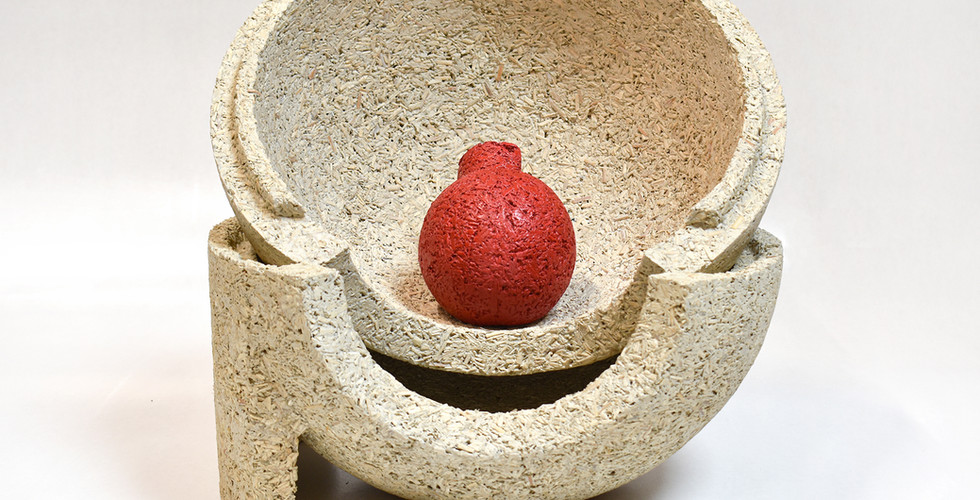Hemp(crete) and cats
- Andrei-Silviu Nitu
- Feb 21, 2024
- 4 min read

If this exploration exercise had been a product we were selling, the presentation would probably have sounded like this:
We created this product with cats' health and comfort at its core. We managed to do this by using a 100% natural material made from hemp wood, lime, and water. The resulting habitat is inspired by nature, non-toxic, antimicrobial, and antifungal. It regulates humidity and temperature, acts as a sound absorber, and controls unpleasant odors and smells, making for the most restful sleep your cat has ever had. Designed to seamlessly integrate into any home, the product showcases raw, unfinished, exposed material, emphasizing that natural materials are inherently imperfect, contributing to their beauty and complexity, which often exceeds the visual spectrum.
It would sound really good and nothing would be an exaggeration. But how do you end up making such a cat and hemp association? Well, the pairing is the result of more than 18 months of studying the industrial hemp market.
After visits to hemp growers in various parts of Europe, we have come to understand why products derived from this plant still have a very low adoption rate. This is despite its extraordinary qualities for the environment and health, being a plant that sequesters more CO2 than a forest and grows rapidly without the need for pesticides.
Our focus has largely been on addressing a significant part of the issue, namely the utilization of 75% of the biomass, represented by hemp wood/ shives. This resource, until recently, was seen as agricultural waste, but in recent years, it has reclaimed its historical utility, specifically in construction. As we delved into hemp wood construction materials, we quickly realized the reasons behind the slow market acceptance. This was attributed to the slow production and the resulting material being very crumbly and brittle. Additionally, manufacturers showed reluctance towards the natural, raw look of the resulting products. However, we discovered wonderful qualities that the material acquires when hemp is mixed with lime and water. The air quality in rooms constructed with this material is far superior to that in rooms built with modern materials. The fact that the walls act as a filter, being a breathable material, where moisture and vapors are not trapped inside, and the high Ph conferred by the lime, which makes it impossible for bacteria and mold to grow, convinced us to investigate this material further. And if the qualities of the material are beneficial to human quality of life, we thought of extending identical benefits to a distinct group of human companions – the cats, the human’s feline friends.
This is how the prototype's story began, and we had to start testing and modifying aspects that seemed impossible to achieve:
Material formula: In order to stop the brittleness and to allow almost unlimited geometric freedom, we enriched the formulation with a compound of organic binders. Simultaneously, this has reduced the drying process. We achieve 70% of the final strength after one day and 100% after 2 - 2.5 weeks of natural drying or 24h oven drying, compared to 5-8 months drying time for the material currently available on the market.
The added binders not only provide strength to the material but also create a natural water-resistant barrier, preserving the vapor permeability properties and the natural filtration qualities of the material.
Forming system: The formula of the material created by us makes for a denser and stickier paste, which allows the use of a unique forming system. In contrast to the classic pressing system (usually one-way pressing with simple molds), the system employed by us allows the use of more complex molds. This makes it possible to create shapes with a high geometric intelligence and in our case to create a den inspired by the hideouts of wild cats.
When we were satisfied with the test results we moved on to the part most loved by industrial designers.
Product details:
The product has been designed to be modular, with two modules forming the cat’s den, and the third module serving as a customizable design element. Having the option to select a color that complements the home's interior while also providing additional support and stability. The three modules seamlessly interlock without the need for adhesives or mechanical assembly, avoiding toxic elements (such as glue) or hard-to-recycle materials (e.g., metal connections or other inserts). The natural look is combined with geometric shapes specific to modern architectural elements, especially of brutalist origin, or shapes found in the 60s and 70s in industrial design.
Being a 100% natural composite design, unlike the products on the market, most of which are made of plastic or combinations of materials that are difficult to separate, after the use cycle the product can be mixed with soil or other organic waste with the ultimate benefit of enriching the soil.
Conclusion:
This prototype was created to test various parameters of our hemp concrete formula, including geometric freedom, drying time, and other aspects. It also served as an initial test for the forming system. Although there are still aspects to be developed and modified, the results are promising.
The upcoming iterations will bring many improvements to the production process, the hempcrete formula, and the visual appearance of the prototypes. We are eager to explore other paths and create more prototypes. Future targets include construction applications and applications for the packaging industry.
P.S.: Did you know that the hearing of our feline friends is three times more easily disturbed than that of humans?









Another amazing, and this time cute and click friendly use, of hempcrete. Well done!
Adorable! Thanks for expanding the uses of #hempcrete!